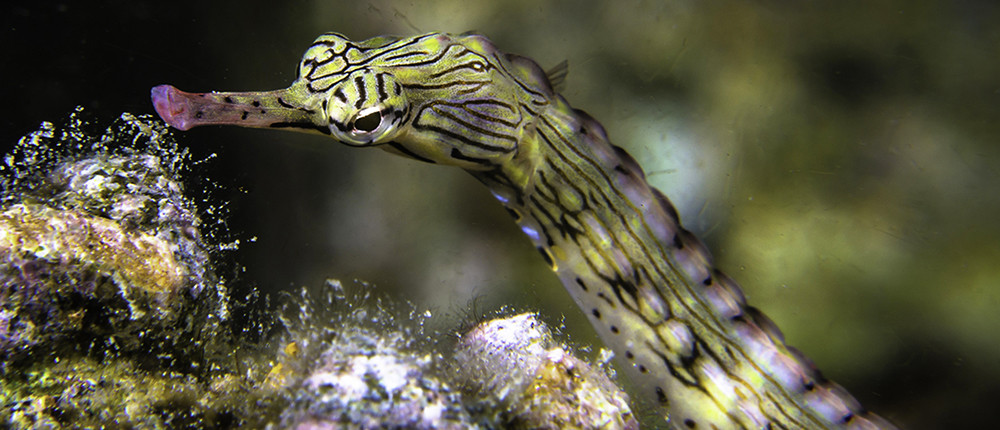Horses, Pipes and Ghosts
When is a horse not a horse? When it’s a seahorse, of course. Yet despite their equine-like appearance, members of genus Hippocampus are every bit a fish, just like a snapper or a tuna. Ditto for other members of the order Syngnathidae–the snake-like pipefish and bizarre ghost pipefish, which also inhabit the reefs and coastal shallows of Wakatobi. It can take a keen eye to spot these unique animals, not only because of their diminutive size, but also because mother nature has endowed them with masterful array of camouflaging that make them difficult to see even when you are looking straight at one.
The smallest of the bunch, the pygmy seahorses, come no larger than a grain of rice. And though somewhat bigger by comparison, members of the ghost pipefish family can so closely resemble a bit of floating sea grass that you could swim within inches without ever realizing that bit of flotsam was a fish. But as you begin to hone your spotting skills, it soon becomes apparent that the waters of Wakatobi are especially good hunting grounds for all manner of horses, pipes and ghosts.

Seahorses have an elongated snout formed by joined upper and lower jaws, turning these slow swimmers into one of the ocean’s fastest feeders. Photo by Rich Carey
About the snout
Seahorses and their close kin, the pipefishes, have undergone some fairly radical physical alterations and adaptations. Tails are twisted or flattened into unusual shapes, bodies are curled or stretched, and fins either shrink or expand, depending on the species. Like most things in nature, there’s a reason why things look the way they do, especially in the case of the snout. With a Greek scientific classification that means “fused jaws,” these animals sport a signature snout formed by the joining of upper and lower jaws into an elongated snout. It is this snout that turns one of the slowest swimming fish in the ocean into one of the fastest feeders.
It’s a good thing that seahorses and pipefish are such highly efficient hunters, because their rudimentary digestive system is fairly inefficient at processing their food, so they must feed almost constantly.
Seahorses and pipefish feed primarily on copeopods. These tiny crustaceans are amazing escape artists, able to speed away at more than 500 body lengths per second. Put in human terms, that would be the equivalent of a swimmer moving at 2,000 miles an hour. To catch a copeopod, a seahorse uses a trick that biologists call “elastic recoil feeding.” In simple terms, the animal stores up energy in the muscles that control head rotation, and release it all at once to create an extremely fast upward pivot of the jaw, which draws the prey in with suction. The entire strike takes place in a single millisecond, and the seahorse catches its prey about 90 percent of the time, which is the most efficient capture rate of any fish ever tested. And it’s a good thing that seahorses and pipefish are such highly efficient hunters, because their rudimentary digestive system is fairly inefficient at processing their food, so they must feed almost constantly. If you run across a seahorse or pipefish at Wakatobi, chances are good that it’s hunting that next meal.

Rather than chase after a meal, seahorses use their strong prehensile tail, which is useless for swimming, to hold them steady as they wait for the food to drift by. This common or thorny seahorse is doing just that. Photo by Luca Vaime
The slowest horse
A seahorse will never win a swim meet, but they can get around just fine at slow speeds. Their distinct torso twist places the dorsal fin in vertical position that allows it to act like a sweep, while their tiny pectoral fins can flutter rapidly for precision maneuvering and hovering. But rather than chase after a meal, they will usually hold in one place and wait for the food to drift past. And that’s where the rear end comes in. The prehensile tail of a seahorse is useless for swimming, but quite good at holding onto things.
At Wakatobi, the species you’re likely to see first are the common horse or the thorny seahorse. It’s not that these animals are that much more abundant, it’s just that at an average of three inches in length, they are a lot easier to spot than the tiny pygmies that hide among the gorgonians. A good place to hunt for the larger seahorses is on grass beds, shallow water rubble fields and soft coral gardens in depths from 3 to 30 feet. These horses are always interesting to watch, and you can usually identify the males by their protruding egg pouches. Because the males get very short breaks between birthing and accepting the next clutch of eggs, there’s a good chance you can witness some aspect of the mating cycle if you devote a few hours to horse hunting.

What at first may look like a branch or bump on a gorgonian may actually be a perfectly-adapted pygmy; in this case a perfect pair of Denise’s pygmies. Did you know the Denise’s was discovered at Wakatobi? Photo by Werner Thiele
Finding a pygmy seahorse, which is among the smallest fish in the sea, can be a bit more difficult than spotting their larger kindred. Of course, you can always tap into the expertise of Wakatobi’s dive guides, as they always have a pretty good idea of where the little creatures are living. Wakatobi is known as one of the best places in the world to find pygmies, and six of the seven known species have been found on our reefs. Because they are poor swimmers, seahorses–especially the pygmies–rely on concealment to escape predators. They are not rapid skin shifters like cuttlefish or octopus, but they can alter their appearance over time to match the patterns of their surroundings. So what at first might look like just a bump on a gorgonian may actually be a perfectly-adapted pygmy. When hunting pygmies, it’s best to go a bit deeper, down into the 60-foot range, as this region lies below the surface wave action that can make it difficult for these tiny animals to hold on to their host.
Flexible pipes
Like seahorses, pipefish possess a lethal snout that can suction up dinner with lightning speed. Beyond that, both physical characteristics and behaviors go separate ways. Pipefish have long, thin bodies, and depending on the species, could be anywhere from one to more than 20 inches in length–though most you’ll find around Wakatobi fall into the two to four inch range. And though their body armor somewhat limits torso flexibility, they often move with a snake-like motion of the torso. And move they will, because unlike seahorses, they are mobile hunters. Many species have blade-like tails to provide locomotion, and they also use the undulations of their body to create forward motion. Though faster than a seahorse, pipefish are still slower than most of the things that would like to eat them, so they too depend on camouflage and concealment to avoid predation.
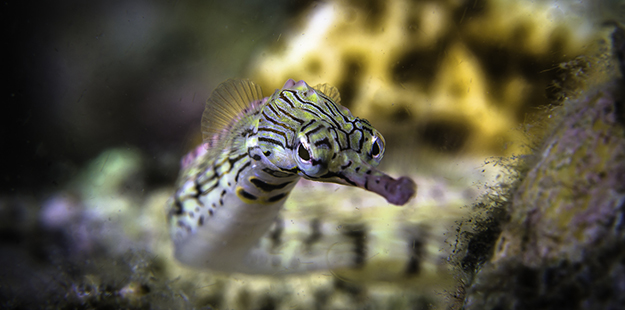
Unlike their kin, the seahorse, pipefish are mobile hunters that can move fast using their tails and lithe body to create forward motion. Photo by Wayne MacWilliams
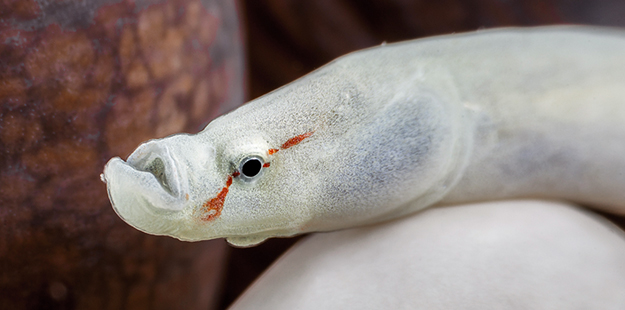
The Mushroom coral pipefish rarely leaves the sanctuary of its host coral, feeding on the tiny organisms that are trapped in the coral’s mucus. Photo by Marco Fierli
Pipefish coloration will often mimic their surroundings, which could be the green of a sea grass bed, the brown of a mud bottom, or the mottled colors of an algae-covered rubble field. One of the easiest species for first-timers to find may be the network pipefish, which often congregate around the rocks of the Wakatobi pier. Growing to lengths of six inches or more, these pipes are easily recognized by the black and yellow/green banded pattern of the body. Like most pipefish, they hunt across a limited range, so if you lose sight of one, stay in the area and you’ll likely run across it again soon. To rack up a second species, look for a stand of mushroom coral, and look close among the tentacles. The mushroom coral pipefish can be difficult to spot at first, as it sports the same greyish color as its host coral. Keep looking, because this animal isn’t going anywhere. It rarely leaves the sanctuary of the enveloping tentacles, and feeds on the small organisms that become trapped in the coral’s mucus. When you find one, you’ll usually find more.
One of the easiest species for first-timers to find may be the network pipefish, which often congregate around the rocks of the Wakatobi pier.
Another promising area to search for pipefish is among the grass beds just of the resort beach. Here, you’ll be looking for one of several species that are doing their best to resemble a blade of grass. Your search may also lead you to an animal that doesn’t seem to fit the rules. The pipehorse has the elongated body of a pipefish, combined with the prehensile tail of a seahorse. They can use that tail to grip a strand of grass and wait for food to pass by, but they can also let go and swim about. You’ll need a keen eye to find one of these hybrids, as most are only an inch or two in length.
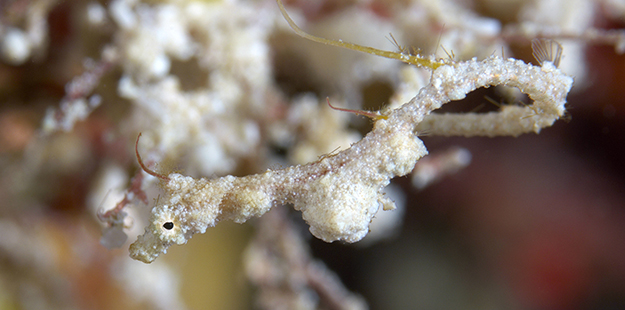
The pipehorse sports an elongated body of a pipefish and prehensile tail of a seahorse; they use the tail for gripping and swimming. Most pipehorses reach no more than two inches in length. Photo by Richard Smith
Ghosts on the reef
Anyone who has dove or snorkeled around Wakatobi has probably come face to face with a ghost pipefish–though they may not have been aware of the encounter. Those who know what they are looking for may recognize what seems to be a drifting scrap of debris or a waving blade of grass as something else. Ghost pipefish are experts at looking like something else, a strategy known as display mimicry. Various species have altered their appearances to resemble everything from leaves and algae to crinoids and sponges. One of the most common species around Wakatobi is the Robust ghost, which has a smooth body that looks very much like a free-floating sprig of sea grass. At the other end of the design spectrum is the Ornate ghost, which sports intricate color patterns and grows s a complex array of protruding appendages to create the feather-like arm of a crinoid. Another interesting subject you may encounter is the Halimeda ghost, which has a more uniform green or brownish coloration and develops large, smooth fins that resemble the leaves of its namesake algae.
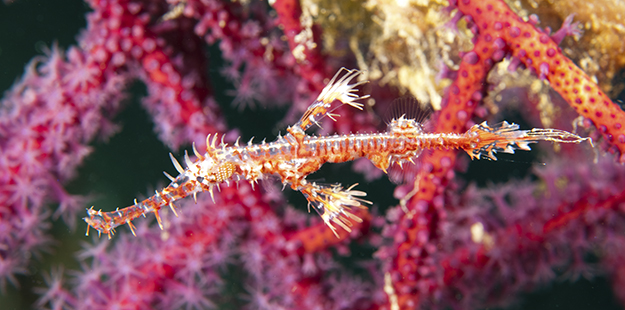
Ghost pipefish can be found everywhere -from shallow rubble fields and grass beds to gorgonians seen here. Photo by Walt Stearns
Once you understand how this mimicry works, you stand your best chance of finding a particular species by searching out a piece of underwater real estate that most resembles that species. When making an ID, it’s best to go by shape rather than color, as members of the same species can take on wide variations in color and patterning depending on the environment in which they live. Ghost pipes usually range in size from two to four inches, and are the most mobile and far-ranging members of the Syngnathidae family. They can be found everywhere from shallow rubble fields and grass beds to crinoids and gorgonians at depths of 100 feet. They often travel in mated pairs, with the female being the larger of the two. At times, ghost pipefish may be discovered drifting with the current, hanging motionless with head down as they hunt. At other times, you may catch them finning slowly from hiding place to hiding place, moving only when the coast seems clear.
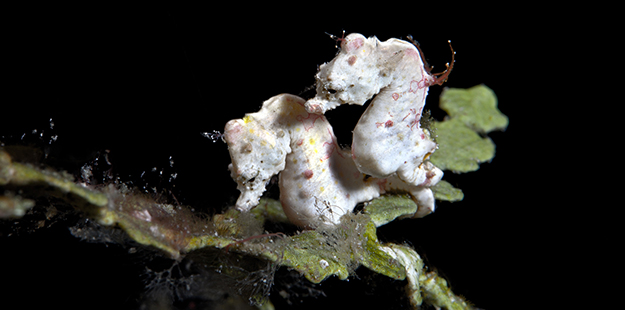
Wakatobi’s resort photo pro, Marco Fierli, captured this stunning image of a pair of Pontoh’s pygmies during a shallow night dive. An educated guess tells us that he may have engaged one of his colleagues to act as a “human tripod.” Photo by Marco Fierli
Capturing the critters
Seahorses, pipefish and ghost pipefish make fascinating subjects for macro photography; the most difficult aspect of capturing one with a camera is finding them. Once located, it is extremely unlikely that they will flee, as these are animals that have evolved to hide rather than run. To exploit this behavior, approach slowly without making any sudden or threatening movements. The animal may orient to cover, and possibly go head down, but they will otherwise stay in place, and give you plenty of time to adjust your camera settings and compose the shot. Any camera setup that can fill the frame with a two-inch subject will work for pipefish and the larger seahorses, while photographing pygmies will require a longer lens and a well-developed sense of that lens’s potential of field. It’s common protocol among responsible underwater photographers to limit the number of flash exposures to which pygmies are subjected, as the lights are thought to stress out these tiny creatures. One trick you can use to create a memorable image without harassing the subject is to take some trial shots on an inanimate piece of structure of approximately the same size and composition as the animal. Once everything is set and ready, you can then turn your attention to your diminutive model. Another technique that a number of photographers use is to have one of Wakatobi’s dive guides hand on them to create a steadying “human tripod” that allows the shooter to move in close while maintaining precise control.
Regardless of whether you are hoping to capture that perfect image of one of nature’s more bizarre creations, or simply want to locate and observe one of these masters of disguise, the reefs of Wakatobi provide one of the ocean’s most fertile hunting grounds. Next time you visit our reefs, make sure to devote some bottom time to finding these amazing animals.
What are you waiting for? It’s a great time to explore options for your next trip at Wakatobi. Contact us at office@wakatobi.com or complete a quick trip inquiry at wakatobi.com.
To view more great Wakatobi imagery visit us on TUMBLR.


